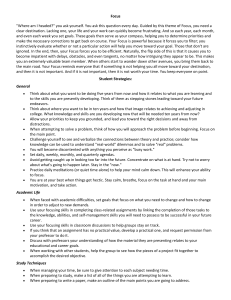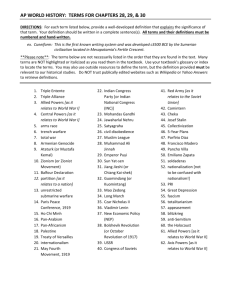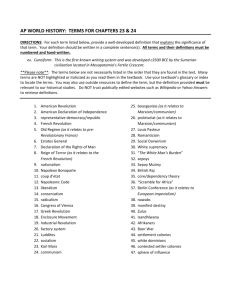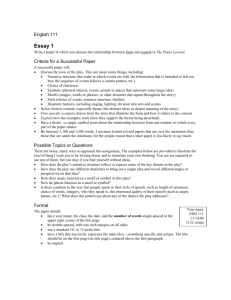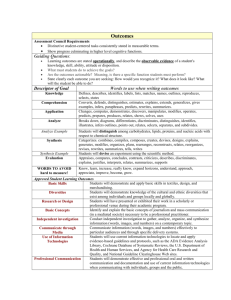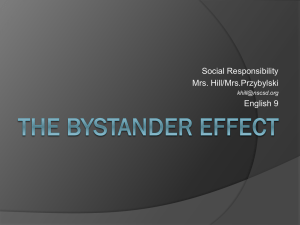Bobo Doll Experiment
advertisement
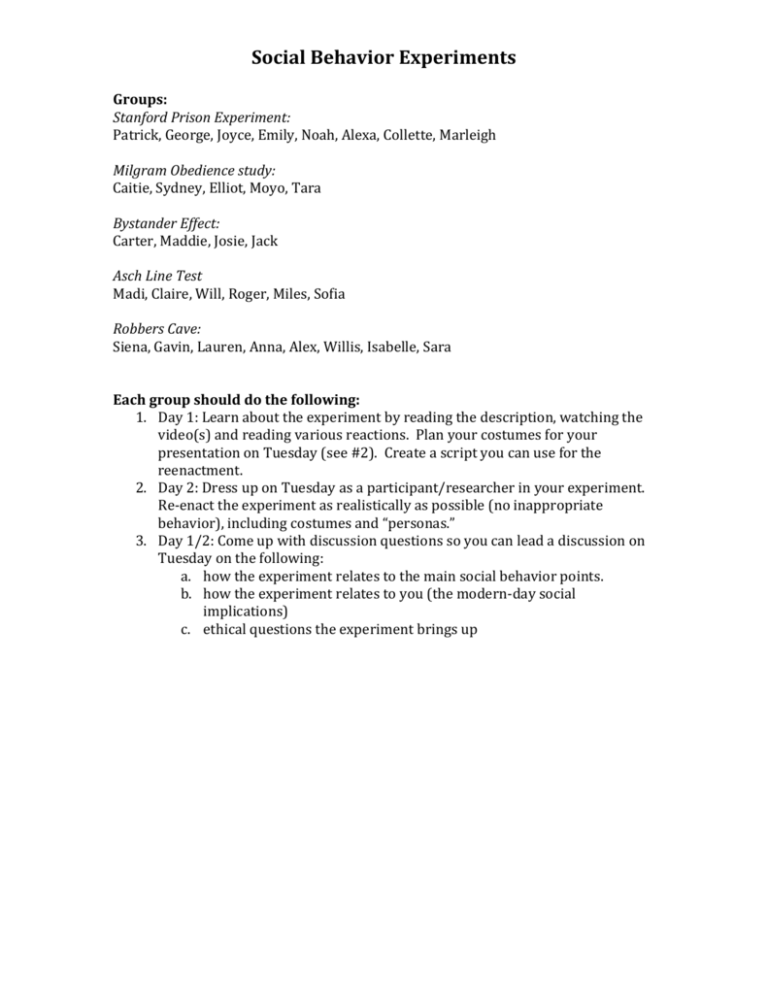
Social Behavior Experiments Groups: Stanford Prison Experiment: Patrick, George, Joyce, Emily, Noah, Alexa, Collette, Marleigh Milgram Obedience study: Caitie, Sydney, Elliot, Moyo, Tara Bystander Effect: Carter, Maddie, Josie, Jack Asch Line Test Madi, Claire, Will, Roger, Miles, Sofia Robbers Cave: Siena, Gavin, Lauren, Anna, Alex, Willis, Isabelle, Sara Each group should do the following: 1. Day 1: Learn about the experiment by reading the description, watching the video(s) and reading various reactions. Plan your costumes for your presentation on Tuesday (see #2). Create a script you can use for the reenactment. 2. Day 2: Dress up on Tuesday as a participant/researcher in your experiment. Re-enact the experiment as realistically as possible (no inappropriate behavior), including costumes and “personas.” 3. Day 1/2: Come up with discussion questions so you can lead a discussion on Tuesday on the following: a. how the experiment relates to the main social behavior points. b. how the experiment relates to you (the modern-day social implications) c. ethical questions the experiment brings up Social Behavior Experiments Roles: 1 experimenter 2 guards 5 prisoners Stanford Prison Experiment THE EXPERIMENT: http://www.experiment-resources.com/stanford-prisonexperiment.html Official experiment website: http://www.prisonexp.org/. You should watch the slideshow and videos to get a sense of the experiment. Zimbardo giving a tour of where the experiment took place: http://www.prisonexp.org/documentary.htm. Watch the movie on the page. Very general overview: http://www.learner.org/discoveringpsychology/19/e19expand.html Written overview of the experiment: http://www.spring.org.uk/2007/09/our-darkhearts-stanford-prison.php Article about the reenactment of the experiment: http://news.bbc.co.uk/2/hi/entertainment/1986889.stm Discussion questions from the Prison Experiment website that might be interesting to bring up: http://www.prisonexp.org/discussion.htm Lessons from the experiment: http://humantesting.suite101.com/article.cfm/lessons_from_the_stanford_prison_experiment Main SOCIAL BEHAVIOR points (from suite101.com): o Some situations can exert powerful influences over individuals, causing them to behave in ways they would not, could not, predict in advance. o Situational power is most noticeable in new settings in which the participants cannot call on previous guidelines for their new behavior and have no historical references to rely on. o Situational power involves ambiguity of role boundaries, authoritative or institutionalized permission to behave in prescribed ways or to disinhibit traditionally disapproved ways of responding. o Role playing -- even when acknowledged to be artificial and temporary -- can still come to exert a profoundly realistic impact on the actors. o Good people can be induced, seduced, initiated into behaving in evil (irrational, stupid, self destructive, antisocial) ways by immersion in "total situations." Social Behavior Experiments Milgram Obedience Experiment Roles: 1 experimenter 4 subjects (one is shocked, the other does the shocking) THE EXPERIMENT: http://www.experiment-resources.com/stanley-milgramexperiment.html BBC experiment footage (three parts): http://www.youtube.com/watch?v=BcvSNg0HZwk Another replication of the experiment: http://www.youtube.com/watch?v=y6GxIuljT3w A French group replicated the experiment for a fake game show. The video and article: http://thelede.blogs.nytimes.com/2010/03/18/wait-wait-dont-torture-me/ A great explanation of the original research and its connections to modern life http://reason.com/archives/2009/01/06/would-you-have-been-a-nazi An article on how this relates to Hitler and the Nazis: http://www.psychologytoday.com/blog/bozo-sapiens/201004/obedience-thelesson-eichmann Main SOCIAL BEHAVIOR points: o Ordinary people are deferential to authority in a laboratory setting o People will do things that they wouldn’t normally do (hurt another person) if they are told to do so by someone in authority o Situation plays a bigger role than personality in terms of how a person will act Each group should do the following: 1. Learn about the experiment by reading the description, watching the video(s) and reading various reactions. 2. Dress up on Tuesday as a participant/researcher in your experiment (see #3) 3. Re-enact the experiment as realistically as possible (no inappropriate behavior), including costumes and “personas.” Create a script you can use for the reenactment. 4. Lead a discussion on the following: a. how the experiment relates to the main social behavior points. b. how the experiment relates to you (the modern-day social implications) c. ethical questions the experiment brings up Social Behavior Experiments Kitty Genovese and the Bystander Effect Roles: Bystanders (4), 1 victim, 1 experimenter/narrator THE EXPERIMENT: http://www.experiment-resources.com/bystander-apathyexperiment.html Two minute video that explains what happened to Kitty Genovese: http://www.youtube.com/watch?v=JozmWS6xYEw&feature=related Video that includes experiments to simulate the bystander effect: http://www.youtube.com/watch?v=OSsPfbup0ac&feature=related A detailed New York Times article about the case and its psychology connections (the first and last pages of the story will be most helpful): http://www.nytimes.com/2004/02/08/nyregion/kitty-40-yearslater.html?pagewanted=1 Another detailed explanation of Kitty Genovese and the connection to the bystander effect: http://riverdaughter.wordpress.com/2009/08/02/a-fascinatingintersection-of-true-crime-psychology-and-media-misinformation/ Overview of the Bystander Effect: http://www.wisegeek.com/what-is-thebystander-effect.htm An experiment that simulated the Bystander Effect: http://www.pineforge.com/newman4study/resources/latane1.htm Connections beyond Kitty Genovese: http://listverse.com/2009/11/02/10notorious-cases-of-the-bystander-effect/ Main SOCIAL BEHAVIOR points: o In ambiguous situations, people will respond to a situation based on the influence of those around them o In groups, people tend to feel a “diffusion of responsibility” and no one ends up responding Each group should do the following: 1. Learn about the experiment by reading the description, watching the video(s) and reading various reactions. 2. Dress up on Tuesday as a participant/researcher in your experiment (see #3) 3. Re-enact the experiment as realistically as possible (no inappropriate behavior), including costumes and “personas.” Create a script you can use for the reenactment. 4. Lead a discussion on the following: a. how the experiment relates to the main social behavior points. b. how the experiment relates to you (the modern-day social implications) c. ethical questions the experiment brings up Social Behavior Experiments Asch Conformity Experiment Roles: 1 experimenter 4 experimenter line judges 1 actual subject THE EXPERIMENT: http://www.experiment-resources.com/asch-experiment.html Additional write-ups: http://www.age-of-the-sage.org/psychology/social/asch_conformity.html http://faculty.babson.edu/krollag/org_site/soc_psych/asch_conform.html Video of the experiment: http://www.youtube.com/watch?v=iRh5qy09nNw Main SOCIAL BEHAVIOR points: o A person will change his/her opinions in order to conform to the group o Social pressure is a strong force that can make people change what they say they believe o Even if only one other person disagrees with the group, an individual will be more able to resist peer pressure Each group should do the following: 1. Learn about the experiment by reading the description, watching the video(s) and reading various reactions. 2. Dress up on Tuesday as a participant/researcher in your experiment (see #3) 3. Re-enact the experiment as realistically as possible (no inappropriate behavior), including costumes and “personas.” Create a script you can use for the reenactment. 4. Lead a discussion on the following: a. how the experiment relates to the main social behavior points. b. how the experiment relates to you (the modern-day social implications) c. ethical questions the experiment brings up Social Behavior Experiments Robber’s Cave Experiment Roles: 6 team members, 3 on each side 2 experimenters THE EXPERIMENT: http://www.experiment-resources.com/robbers-caveexperiment.html Write-ups of the experiment: http://www.spring.org.uk/2007/09/war-peace-and-role-of-power-in-sherifs.php http://www.ppu.org.uk/learn/peaceed/pe_robbers_cave.html http://psychclassics.asu.edu/Sherif/ http://www.age-of-thesage.org/psychology/social/sherif_robbers_cave_experiment.html Blog entry about the experiment: http://lesswrong.com/lw/lt/the_robbers_cave_experiment/ Audio from the experiment (really hard to hear, with some images of the boys): http://www.youtube.com/watch?v=DShYwlcLsHc Main SOCIAL BEHAVIOR points: o Stopping fighting between two hostile groups isn’t enough to change behavior o When there are limited resources, conflict, prejudice and discrimination can result o Once hostility has been aroused, it is difficult to reverse the prejudices that have developed o Group identity and hostile discrimination is easily established by encouraging competition Each group should do the following: 1. Learn about the experiment by reading the description, watching the video(s) and reading various reactions. 2. Dress up on Tuesday as a participant/researcher in your experiment (see #3) 3. Re-enact the experiment as realistically as possible (no inappropriate behavior), including costumes and “personas.” Create a script you can use for the reenactment. 4. Lead a discussion on the following: a. how the experiment relates to the main social behavior points. b. how the experiment relates to you (the modern-day social implications) c. ethical questions the experiment brings up Social Behavior Experiments Roles: 1 adult “model” 2 children Bandura Bobo Doll Experiment THE EXPERIMENT: http://www.experiment-resources.com/bobo-dollexperiment.html Video that shows and explains the original experiment: http://www.youtube.com/watch?v=vdh7MngntnI Main SOCIAL BEHAVIOR points: o People respond to social modeling o Children who are exposed to aggression are sometimes more likely to be aggressive themselves o Bring up issues/problems with this study
